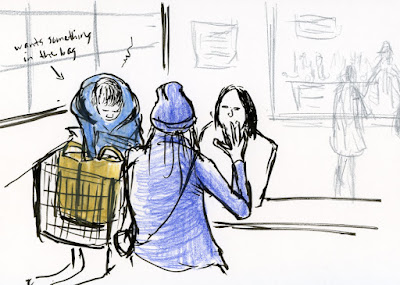 |
| Art Stand desktop easel |
When I attended Crystal Shin’s colored pencil botanical workshop, her students were all impressed with her small desktop easel. The
easily portable easel folded flat when she wasn’t using it, and the drawing
board adjusted to various angles. The improved ergonomics offered by the easel
is especially useful to professional illustrators like Crystal who spend many
hours a day making detailed drawings, which can be very hard on the neck and
shoulders. Although I don’t work on pieces that keep me at my desk for long, consecutive
hours, I have certainly gotten a stiff neck from hunching over my work table for
longer than I should. Good ergonomics are important for everyone.
Handmade by a woodworker in Portland, the Art Stand easel
turned out to be much more affordable than I had imagined. Made of sustainably
harvested Oregon Black Walnut (also called Settler’s Black Walnut), the $55
price includes an Ampersand Hardbord drawing surface. I contacted Ray Tanner
right away, and a few weeks later, it was on my desk!
The easel I received, however, is not his standard design. I
wrote to him explaining that while I occasionally use loose sheets, my primary paper
is in sketchbooks – specifically, softcover Stillman & Birn sketchbooks
in the 5½-by-8½ -inch format. I asked whether the lip on the edge of the easel
would be wide enough to support a sketchbook, and if not, whether he could
customize one to meet my needs.
Ray had a variety of sketchbooks at his disposal, including
exactly the same kind I use, so he was able to test whether the standard easel
would work. He tried various mechanisms, including using a clip to hold the book
against the drawing board, but thought that an additional, slightly wider lip
would serve me best. Since he makes each easel to order, he was able to
accommodate my request for only a small additional charge. I was thrilled!
It fits nicely on my desktop, and when I’m not using it, I
fold it up and store it under my desk. Slender and weighing only a pound and a
half, it could easily be popped into a tote bag to take to class. The only
change I had to make in my general desktop setup was to find a way to elevate
my drawing subject so that I could see it over the top of the drawing board.
With my typically small still life subjects like fruit, I just place them on an
upturned coffee mug.
 |
| Stillman & Birn sketchbook in portrait orientation |
The first thing I worked on with the easel was my egg exercises, and I immediately noticed one huge improvement: My light was no
longer glaring directly on the paper and especially on shiny graphite. All
these years, I have always had to tilt my sketchbook up at a slight angle to avoid the glare by
leaning it against an object that would slide around or simply holding it at an angle
with my other hand. The Art Stand is the solution I had been looking for!
Ray Tanner does not have a website. If you have serious
interest in the Art Stand, please leave a comment below with your email address,
and I’ll send you Ray’s PDF with full details and specs.
 |
| Easel shown without drawing board. |
 |
| Folded easel flat on the desktop |
 |
| Thin and lightweight! |








































